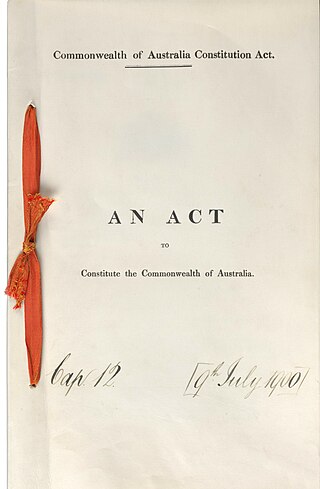Related Research Articles

The High Court of Australia is the apex court of the Australian legal system. It exercises original and appellate jurisdiction on matters specified in the Constitution of Australia and supplementary legislation.
In many Commonwealth jurisdictions, the phrase "peace, order, and good government" (POGG) is an expression used in law to express the legitimate objects of legislative powers conferred by statute. The phrase appears in many Imperial Acts of Parliament and Letters Patent, most notably the constitutions of Barbados, Canada, Australia and formerly New Zealand and South Africa.
Australian constitutional law is the area of the law of Australia relating to the interpretation and application of the Constitution of Australia. Legal cases regarding Australian constitutional law are often handled by the High Court of Australia, the highest court in the Australian judicial system. Several major doctrines of Australian constitutional law have developed.

Ultra vires is a Latin phrase used in law to describe an act that requires legal authority but is done without it. Its opposite, an act done under proper authority, is intra vires. Acts that are intra vires may equivalently be termed "valid", and those that are ultra vires termed "invalid".
The Australian Government, also known as the Commonwealth Government, is the national government of Australia, a federal parliamentary constitutional monarchy. The government consists of the parliamentary members of the party or coalition that currently has the support of a majority of members of the House of Representatives and in some contexts also includes the departments and other executive bodies ministers oversee. The current government consists of Anthony Albanese and other Australian Labor Party parliamentarians, in place since the 2022 federal election.
Article IV, Section 1 of the United States Constitution, the Full Faith and Credit Clause, addresses the duty that states within the United States have to respect the "public acts, records, and judicial proceedings of every other state." According to the Supreme Court, there is a difference between the credit owed to laws as compared to the credit owed to judgments. Judges and lawyers agree on the meaning of the clause with respect to the recognition of judgments rendered by one state in the courts of another. Barring exceptional circumstances, one state must enforce a judgment by a court in another, unless that court lacked jurisdiction, even if the enforcing court otherwise disagrees with the result. At present, it is widely agreed that this Clause of the Constitution has a minimal impact on a court's choice of law decision provided that no state's sovereignty is infringed, although this Clause of the Constitution was once interpreted to have greater impact.

The Constitution Alteration (Aviation) Bill 1936, was an unsuccessful proposal to alter the Australian Constitution to extend the Commonwealth legislative power in respect to air navigation and aircraft. It was put to voters for approval in a referendum held on 6 March 1937.

Commonwealth v Tasmania was a significant Australian court case, decided in the High Court of Australia on 1 July 1983. The case was a landmark decision in Australian constitutional law, and was a significant moment in the history of conservation in Australia. The case centred on the proposed construction of a hydro-electric dam on the Gordon River in Tasmania, which was supported by the Tasmanian government, but opposed by the Australian federal government and environmental groups.

Amalgamated Society of Engineers v Adelaide Steamship Co Ltd, commonly known as the Engineers case, was a landmark decision by the High Court of Australia on 31 August 1920. The immediate issue concerned the Commonwealth's power under s51(xxxv) of the Constitution but the court did not confine itself to that question, using the opportunity to roam broadly over constitutional interpretation.

The legal system of Australia has multiple forms. It includes a written constitution, unwritten constitutional conventions, statutes, regulations, and the judicially determined common law system. Its legal institutions and traditions are substantially derived from that of the English legal system. Australia is a common-law jurisdiction, its court system having originated in the common law system of English law. The country's common law is the same across the states and territories.

Federalism was adopted, as a constitutional principle, in Australia on 1 January 1901 – the date upon which the six self-governing Australian Colonies of New South Wales, Queensland, South Australia, Tasmania, Victoria, and Western Australia federated, formally constituting the Commonwealth of Australia. It remains a federation of those six original States under the Constitution of Australia.
Section 109 of the Constitution of Australia is the part of the Constitution of Australia that deals with the legislative inconsistency between federal and state laws, and declares that valid federal laws override inconsistent state laws, to the extent of the inconsistency. Section 109 is analogous to the Supremacy Clause in the United States Constitution and the paramountcy doctrine in Canadian constitutional jurisprudence, and the jurisprudence in one jurisdiction is considered persuasive in the others.
Section 51(xxvi) of the Constitution of Australia, commonly called "the race power", is the subsection of Section 51 of the Constitution of Australia granting the Australian Commonwealth the power to make special laws for people of any race.
The reserved powers doctrine was a principle used by the inaugural High Court of Australia in the interpretation of the Constitution of Australia, that emphasised the context of the Constitution, drawing on principles of federalism, what the Court saw as the compact between the newly formed Commonwealth and the former colonies, particularly the compromises that informed the text of the constitution. The doctrine involved a restrictive approach to the interpretation of the specific powers of the Federal Parliament to preserve the powers that were intended to be left to the States. The doctrine was challenged by the new appointments to the Court in 1906 and was ultimately abandoned by the High Court in 1920 in the Engineers' Case, replaced by an approach to interpretation that emphasised the text rather than the context of the Constitution.
Section 51(xxxvii) of the Constitution of Australia is a provision in the Australian Constitution which empowers the Australian Parliament to legislate on matters referred to it by any state. As Australia is a federation, both states and the Commonwealth have legislative power, and the Australian Constitution limits Commonwealth power. Section 51(xxxvii) allows for a degree of flexibility in the allocation of legislative powers.

New South Wales v Commonwealth is a landmark decision of the High Court of Australia, which held that the federal government's WorkChoices legislation was a valid exercise of federal legislative power under the Constitution of Australia. In essence, the majority found the Constitution's corporations power capable of sustaining the legislative framework, while the conciliation and arbitration and territories powers were also seen as supporting parts of the law. Furthermore, the majority also held that the legislation permissibly limited State powers and did not interfere with State constitutions or functioning. A minority dissented.

The Constitution of Australia is the supreme law of Australia. It is a written constitution that sets down the political structure of Australia as a federation under a constitutional monarchy governed with a parliamentary system and outlines the structure and powers of the Commonwealth of Australia's three constituent parts: the executive, legislature, and judiciary.
Section 116 of the Constitution of Australia precludes the Commonwealth of Australia from making laws for establishing any religion, imposing any religious observance, or prohibiting the free exercise of any religion. Section 116 also provides that no religious test shall be required as a qualification for any office or public trust under the Commonwealth. The product of a compromise in the pre-Federation constitutional conventions, Section 116 is based on similar provisions in the United States Constitution. However, Section 116 is more narrowly drafted than its US counterpart, and does not preclude the states of Australia from making such laws.
In Australia, the doctrine of intergovernmental immunity defines the circumstances in which Commonwealth laws can bind the States, and where State laws can bind the Commonwealth. This is distinct from the doctrine of crown immunity, as well as the rule expressed in Section 109 of the Australian Constitution which governs conflicts between Commonwealth and State laws.
Parliamentary sovereignty, also called parliamentary supremacy or legislative supremacy, is a concept in the constitutional law of some parliamentary democracies. It holds that the legislative body has absolute sovereignty and is supreme over all other government institutions, including executive or judicial bodies. It also holds that the legislative body may change or repeal any previous legislation and so it is not bound by written law or by precedent.
References
- ↑ Constitution (Cth) s 118 Recognition of laws etc. of States.
- ↑ Aitken, G. 2003. Sawyer's: The Australian Constitution. Canberra, Australian Government Solicitor. See also Saunders, C. 2000. The Australian Constitution (Annotated). 3rd Edition. Canberra, Constitutional Centenary Foundation.
- ↑ Aroney, N. 2009. The Constitution of a Federal Commonwealth. Cambridge, CUP. p. 288.
- ↑ Saunders,C. 2000. The Australian Constitution Annotated. Carlton, Constitutional Centenary Foundation. p.117.
- ↑ Aroney, N. 2009. The Constitution of a Federal Commonwealth. Cambridge, CUP. pp. 41, 70, 87, 104–9, 126–7, 150–2, 156–7, 194, 200, 217, 225–6, 233, 235, 301–2, 329–30, 337, 342–3.